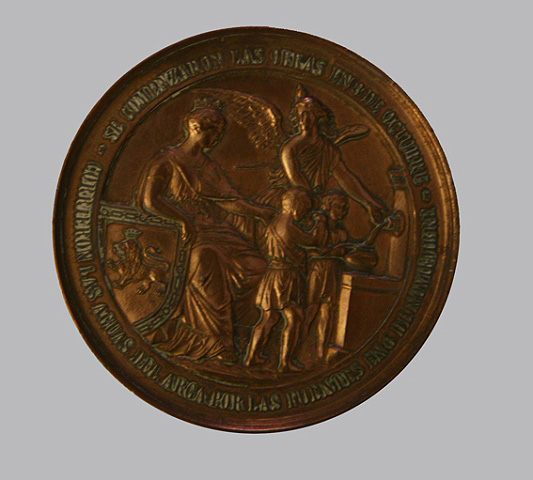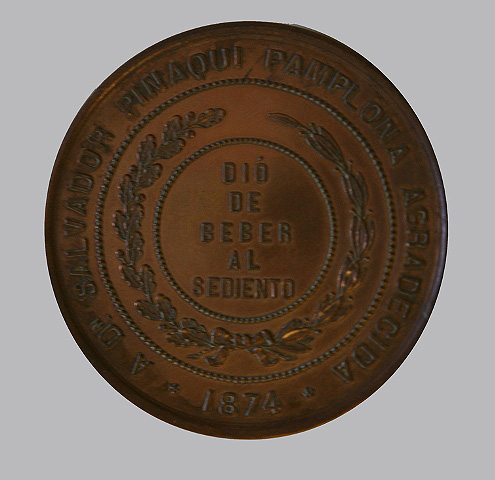The piece of the month of January 2011
COMMEMORATIVE MEDAL OF THE RISE OF THE ARGA RIVER WATERS (1876)
Eduardo Morales Solchaga
Chairof Navarrese Heritage and Art
Commemorative copper medal commemorating the rising waters of the Arga, during the Carlist blockade of Pamplona. It is necessary to go back to 1874 to understand the coinage presented here, specifically to September 14, when the followers of Don Carlos cut off the water supply to Subiza, leaving place without water supply and with obvious health problems. The difficulties fueled the ingenuity of Salvador Pinaqui Ducasse (1817 - 1890), industrialist of Bayonne, established in the capital of the Old Kingdom, to whose position ran a copper foundry, settled on the banks of the Arga. Pinaqui enjoyed great prestige in the city, introducing the electric current in the same one and projecting the ascent of waters to San Cristóbal, among other actions of interest. In the industrial field, he specialized in the production and sale of agricultural machinery, which earned him numerous recognitions (sponsored by the Diputación de Navarra and the board of Agriculture and emeritus member of the Sociedad de Labradores de Valencia), awards (exhibition Nacional de Agricultura, gold medal - Madrid, 1857; exhibition Agrícola de Pamplona, gold medal - 1864; exhibition Universal de París, silver medal - 1867), and commendations, such as that of Carlos III, in 1875.
On October 1, he discovered a spring of high quality water in the waterfall below the dam, in front of the Caparroso mill. With municipal financing, and after great efforts, he managed to install a turbine, which in turn moved three water pumps, which took the liquid element to the water tank of Subiza, next to the basilica of San Ignacio, from where it was distributed to the well-known network of fountains of the capital, materialized the previous century, according to project of Luis Paret y Alcázar. The inauguration of the aforementioned fountain took place on November 6, with the place del Castillo and the source de la Mari Blanca as the incomparable framework , having been preserved testimonies of great interest, both literary and pictorial, of the singular rejoicing that permeated the population of Pamplona, on which it is not necessary to insist.
This event became, due to its transcendence, one of the most important milestones of the blockade and, even before the end of the blockade, the city council wanted to thank the Gallic industrialist at sample . For this reason, on January 3, 1875, it agreed to award him with a commemorative gold medal, whose model follows the one presented here. The dies for the medal, currently conserved in the file Municipal de Pamplona and probably made in France, arrived in 1876, since on June 10th "it was agreed to address a exhibition to the Hon. Minister of Finance, in order to obtain his permission so that the minting of the gold medal that the City Council will award to Don Salvador Pinaqui, for the very important service he rendered to this town, raising the waters of the river, be carried out in the mint, with another fifty copper coins so that the work would be as perfect as possible". The answer was indeed favorable, thanks to the good work of Crisóstomo García, commissioner in Madrid, and the dies traveled to the capital, where the commemorative medal was finally minted.

Medal commemorating the rise of the Arga river (1876). Obverse
Madrid Mint; 1876 (French dies).
Copper. 6cm. /diam.
Private Collection
With regard to its configuration, on its front face it presents a symbolic composition, with an allegory of Pamplona, in the manner of a Roman matron and identified by the arms of the city, accompanied by two sons, in reference letter to its inhabitants, who hurry to drink water from the source in a pitcher. Presiding over the composition and opening the water conduction, a guardian angel, symbolizing Salvador Pinaqui. All this is surrounded by the explanatory legend of the process: "The works began on October 3/ The waters of the Arga flowed through the fountains on November 6". The reverse of the same one is sample much simpler, presiding over the center the phrase "He gave drink to the thirsty", in reason to the well-known work of mercy, surrounded by a triumphal crown of laurel leaves. Surrounding the perimeter, the legend accrediting the event: "A Dn. Salvador Pinaqui, Pamplona agradecida/ 1874".
The gold medal, addressed to Pinaqui, arrived in August of 1876, being given to him that same month "begging him on behalf of the City Council to accept it, as eternal test of gratitude for the good wishes that encourage him, in favor of the intelligent and tireless genius to whom it is dedicated". In the possession of the Town Hall, apart from the luxurious case with the dies, there remained a silver medal, which is described by Dr. Arazuri in one of his most famous monographs and even reproduced in the magazine "Pregón".

Medal commemorating the rise of the waters of the Arga (1876). Reverse
Madrid Mint; 1876 (French dies).
Copper. 6cm. /diam.
Private Collection
Also conserved in the aforementioned institution, as we have been able to verify, is a copper coin, similar to the one studied here, and of which model was ordered, also from the Casa de la Moneda of Madrid, half a hundred. The latter arrived in Pamplona on November 18, 1876, giving an account of the fact and to whom the conference proceedings of that day were to be delivered: "There was also a present from Mr. Mayor that the coins had been received from the Madrid Mint. Mayor that the fifty medals had been received, copper reproduction of the gold medal that the City Council agreed to dedicate to Don Salvador Pinaqui, for the great service he rendered to this city during the last blockade that it suffered, by carrying out the project of elevation of the waters of the river to supply the neighborhood, which was deprived of it because the Carlists interrupted the course of those that came by the old Subiza trip. It was agreed to distribute them among all the councilmen, also giving them to His Excellency Mr. Captain General; Mr. General; second corporal; Mr. Auditor of War; Mr. Civil Governor; Mr. President and Prosecutor of the Audiencia of the Territory; Mr. Judge of First written request; Mr. Bishop of this Diocese; Mr. Colonel; Lieutenant Colonel of Engineers, Paulino Aldaz; Mr. Provincial Deputy and Secretary; Mr. Director of the Provincial high school ; Mr. President of the Commission of Historical-Artistic Monuments of Navarre; and Messrs. Aniceto Lagarde, Don Juan Vilella, Don Nicasio Landa, Don Pedro María Irigoyen, Don José María Villanueva, and Don Crisóstomo Garcia, from Madrid, who was in charge of the necessary diligences for the contracting". It is one of these subjects, all of them relevant in the social, political, religious or military spheres of the capital, to whom the present commemorative medal fell, preserved today in private hands.
bibliography
- file Municipal de Pamplona. conference proceedings del Ayuntamiento. 1876.
- ARAZURI, J. J., Pamplona Antaño, Pamplona, 1969, pp. 58 - 59.
- FLORISTÁN, A., "Pinaqui Ducasse, Salvador" in Gran Enciclopedia de Navarra Online.
- IDOATE, F., "Diario del bloqueo puesto por los carlistas a la place de Pamplona desde el 27 de agosto de 1874 a 2 de febrero de 1875" in Príncipe de Viana, nº 84 - 85 (1961), pp. 217 - 231.
